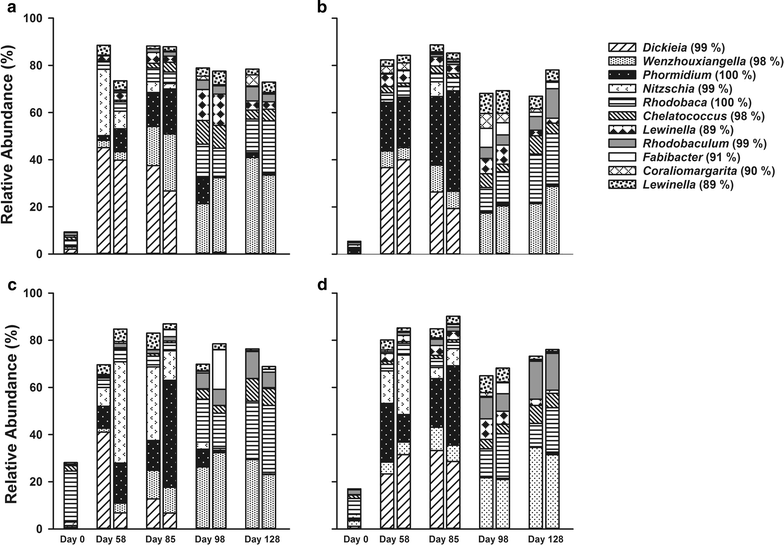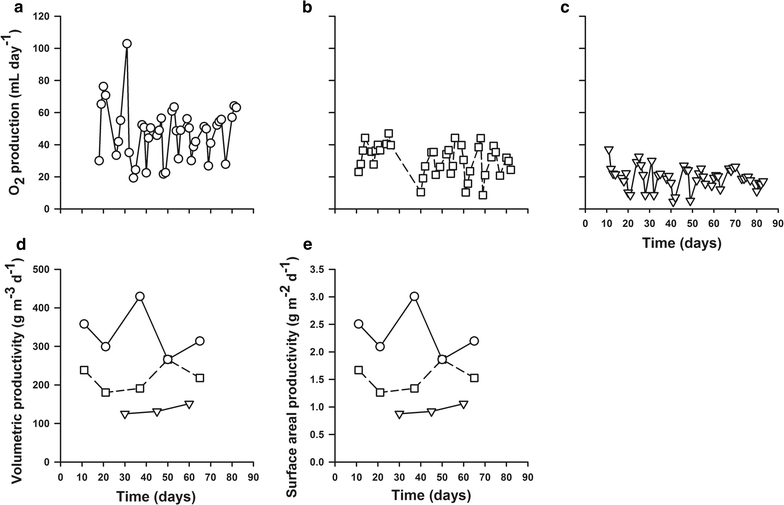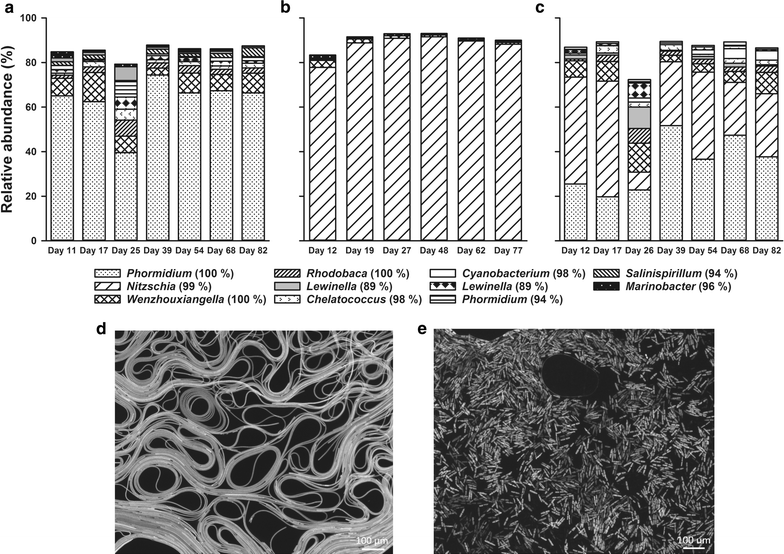Robust, high-productivity phototrophic carbon capture at high pH and alkalinity using natural microbial communities
- PMID: 28367229
- PMCID: PMC5372337
- DOI: 10.1186/s13068-017-0769-1
Robust, high-productivity phototrophic carbon capture at high pH and alkalinity using natural microbial communities
Abstract
Background: Bioenergy with carbon capture and storage (BECCS) has come to be seen as one of the most viable technologies to provide the negative carbon dioxide emissions needed to constrain global temperatures. In practice, algal biotechnology is the only form of BECCS that could be realized at scale without compromising food production. Current axenic algae cultivation systems lack robustness, are expensive and generally have marginal energy returns.
Results: Here it is shown that microbial communities sampled from alkaline soda lakes, grown as biofilms at high pH (up to 10) and high alkalinity (up to 0.5 kmol m-3 NaHCO3 and NaCO3) display excellent (>1.0 kg m-3 day-1) and robust (>80 days) biomass productivity, at low projected overall costs. The most productive biofilms contained >100 different species and were dominated by a cyanobacterium closely related to Phormidium kuetzingianum (>60%).
Conclusion: Frequent harvesting and red light were the key factors that governed the assembly of a stable and productive microbial community.
Keywords: Algae biofuel; Biofilm; Microbial ecology; Mixed-community; Phormidium kuetzingianum.
Figures




Similar articles
-
Direct capture and conversion of CO2 from air by growing a cyanobacterial consortium at pH up to 11.2.Biotechnol Bioeng. 2019 Jul;116(7):1604-1611. doi: 10.1002/bit.26974. Epub 2019 Apr 8. Biotechnol Bioeng. 2019. PMID: 30906982 Free PMC article.
-
Use of highly alkaline conditions to improve cost-effectiveness of algal biotechnology.Appl Microbiol Biotechnol. 2016 Feb;100(4):1611-1622. doi: 10.1007/s00253-015-7208-7. Epub 2015 Dec 22. Appl Microbiol Biotechnol. 2016. PMID: 26691517 Review.
-
Can biomass supply meet the demands of bioenergy with carbon capture and storage (BECCS)?Glob Chang Biol. 2020 Oct;26(10):5358-5364. doi: 10.1111/gcb.15296. Epub 2020 Aug 20. Glob Chang Biol. 2020. PMID: 32726492
-
Can bioenergy carbon capture and storage aggravate global water crisis?Sci Total Environ. 2020 Apr 20;714:136856. doi: 10.1016/j.scitotenv.2020.136856. Epub 2020 Jan 22. Sci Total Environ. 2020. PMID: 32018988
-
Biofilm-based algal cultivation systems.Appl Microbiol Biotechnol. 2015 Jul;99(14):5781-9. doi: 10.1007/s00253-015-6736-5. Epub 2015 Jun 16. Appl Microbiol Biotechnol. 2015. PMID: 26078112 Review.
Cited by
-
Proteome and strain analysis of cyanobacterium Candidatus "Phormidium alkaliphilum" reveals traits for success in biotechnology.iScience. 2021 Nov 6;24(12):103405. doi: 10.1016/j.isci.2021.103405. eCollection 2021 Dec 17. iScience. 2021. PMID: 34877483 Free PMC article.
-
Ecological Interactions of Cyanobacteria and Heterotrophs Enhances the Robustness of Cyanobacterial Consortium for Carbon Sequestration.Front Microbiol. 2022 Feb 11;13:780346. doi: 10.3389/fmicb.2022.780346. eCollection 2022. Front Microbiol. 2022. PMID: 35222325 Free PMC article.
-
Autofermentation of alkaline cyanobacterial biomass to enable biorefinery approach.Biotechnol Biofuels Bioprod. 2023 Apr 8;16(1):62. doi: 10.1186/s13068-023-02311-5. Biotechnol Biofuels Bioprod. 2023. PMID: 37029442 Free PMC article.
-
Interaction between CO2-consuming autotrophy and CO2-producing heterotrophy in non-axenic phototrophic biofilms.PLoS One. 2021 Jun 15;16(6):e0253224. doi: 10.1371/journal.pone.0253224. eCollection 2021. PLoS One. 2021. PMID: 34129611 Free PMC article.
-
Role of Extracellular Carbonic Anhydrase in Dissolved Inorganic Carbon Uptake in Alkaliphilic Phototrophic Biofilm.Front Microbiol. 2018 Oct 22;9:2490. doi: 10.3389/fmicb.2018.02490. eCollection 2018. Front Microbiol. 2018. PMID: 30405559 Free PMC article.
References
-
- Chase JM, Leibold MA. Ecological niches: linking classical and contemporary approaches. Chicago: University of Chicago Press; 2003.
-
- Gough C, Upham P. Biomass energy with carbon capture and storage (BECCS or Bio-CCS) Greenh Gases. 2011;1(4):324–334. doi: 10.1002/ghg.34. - DOI
LinkOut - more resources
Full Text Sources
Other Literature Sources

